A Beginner’s Guide
Be they luxurious palaces, rustic warehouses, simple halls or stone sanctuaries, Hindu temples are springing up all over the world, numbering in the hundreds of thousands. Yet outside of India and a few places like Sri Lanka, Nepal and Bali, what happens inside these temples remains a mystery—to young generations of Hindus as well as to curious newcomers. It’s all a bit intimidating at first. This Insight is designed to answer the common questions that arise: Why are temples important? What are the customs and protocols, the dos and don’ts? What attitudes should one hold inside? Do all those rituals have a meaning? What is the priest chanting? All these musings and more are addressed here to help newcomers—both Hindus and non-Hindus—enjoy and benefit from their temple visits.
Hindu Temples Are Not All Alike
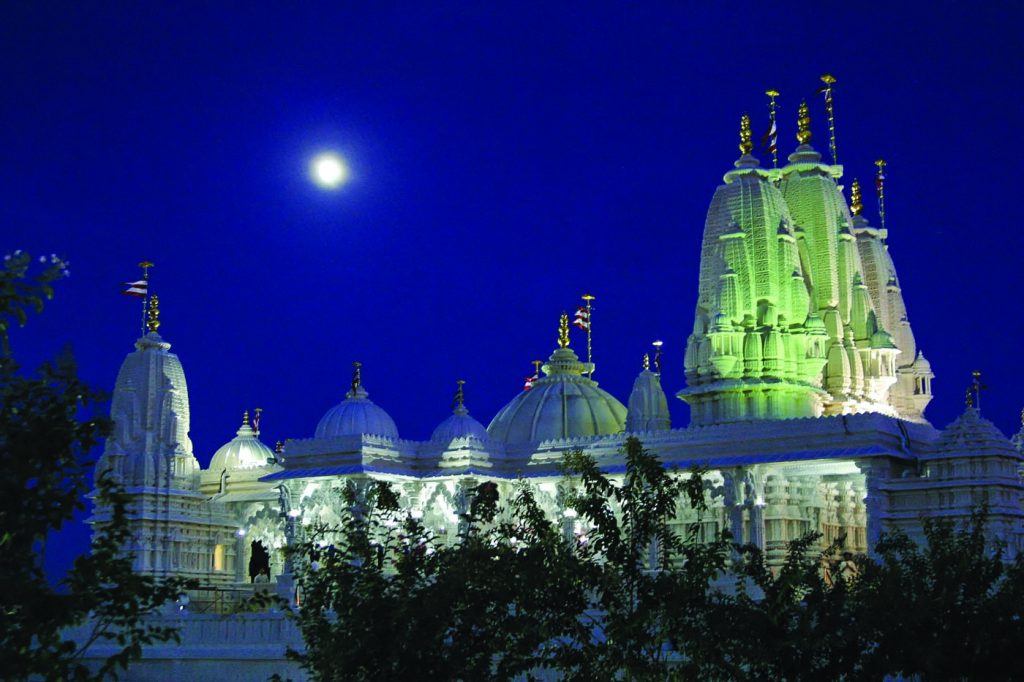
baps swaminarayan sanstha
Ideally, temples (often called mandirs) are built in accordance with the ancient scriptures, planned out by skilled Indian architects to resemble the traditional styles found in India. This ideal temple has certain features: 1) a central sanctum enshrines the main Deity; 2) other Deities in the pantheon are represented by murtis in secondary sanctums or shrines; 3) the structure has no basement; 4) cultural and social activities are provided for in separate facilities, not in the main area dedicated for worship; 5) trained, ordained priests perform a daily regimen of pujas (others do not enter the shrines); 6) the temple openly represents a particular denomination of Hinduism and a specific lineage of teaching and liturgy.
While these principles are well known among the thousands of communities of Hindus around the world, the reality is that each temple comes up in its own way, organically, with the above ideals flexing with the exigencies of the day, the resources and often-mixed geographical background of the constituents. Hence, we now have a vast variety of temples, particularly outside India, each serving the needs of its community as a center of worship, culture, community service and spiritual fellowship.
Every temple is unique. Agamic temples provide elaborate pujas several times per day. The main Deities are in distinct, prominent sanctums. Individuals come and go at any time and worship privately or as a family. Other temples may be structured as a simple hall with a stage in front, and Deities on pedestals usually around the perimeter of the room. The style of worship here is often congregational, with temple members gathering at a set time for a structured service conducted by a priest or elder. In some mandirs devotees may do a simple puja themselves. Services may include some form of teaching, such as a lecture by a swami or lay leader, and devotional singing or dramatic readings from the epics, Ramayana and Mahabharata.
Here is the format followed at the Hindu temple in Midland, Texas, as described by Dr. Padmaja Patel: “Every week on Sunday we gather at our temple from 10:30 to 12:30. After removing our shoes in our shoe room, we enter the main hall. The men and women sit separately. There are a set of shlokas and stutis that everyone chants together, followed by bhajans, which are usually in the call-and-response fashion. At the end of the session, our priest will perform a short puja to a particular Deity. Then we sing a food-offering song, followed by the ‘Om Jai Jagadish Hare’ arati, where everyone
Quick Start…
Dress modestly, no shorts or short skirts. Remove shoes before entering. Be respectful of God and the Gods. Bring your problems, prayers or sorrows but leave food and improper manners outside. Do not enter the shrines without invitation or sit with your feet pointing toward the Deities or another person. Refrain from gossip and worldly talk. Mute your cell phone. Treat the priests with respect and obey visitor signs. Men and women avoid hugging and other demonstrations of affection, and usually sit separately. Enjoy a spiritual time in this holy sanctuary.
Why Are Temples Needed?
By Satguru Bodhinatha Veylanswami
A few years ago at a temple in Australia, while I was chatting with sons and daughters of key members, one youth challenged: “Swamiji, since God is omnipresent, what is the need to build large temples to worship Him? The cost of construction is large, plus then you have the ongoing cost of monthly maintenance that has to be met. Couldn’t all that money be spent in a better way?”
“Good question!” I responded. “Yes, it is true that God is everywhere, permeating everything, including this room. By looking intently around us, we should be able to experience God, right? But look around you now. How many of you can see God?” They all smiled and admitted they could not. I continued: “Practically speaking, God’s omnipresence is at a very subtle level, too subtle for most of us to experience without a lot of experience in meditation.”
That’s how I explain the need for the Hindu temple: it is a special space in which the inner and outer worlds commune and we can experience Divinity. If we want to see a distant galaxy, we can go to an observatory and look through a powerful telescope. To see into the nucleus of a cell, we go to a laboratory and use a microscope. Similarly, to know God, we can go to the temple and experience Divinity through the sanctified murti. Temples are especially sacred for three reasons: construction, consecration and continuous daily worship.
Hereditary temple architects, known as sthapatis, are commissioned to design and construct the temple according to the sacred architecture found in the Agamic scriptures. Consecration occurs through the powerful ceremony of kumbhabhishekam, with many priests performing elaborate rituals for several days. Then begins the perpetual schedule of obligatory pujas conducted by highly trained priests. These daily pujas sustain and build on the power set in motion at the kumbhabhishekam.
What Is Puja All About?

The Hindu worship service called puja, literally “adoration,” is the central activity in most temples. Conducted by a priest, or pujari, puja is similar to a grand reception for a king. The ritual can last from ten minutes to several hours.
All pujas follow one basic pattern. First, the pujari purifies himself, the sacred implements and the place of worship. He chants in Sanskrit the time, place and nature of this particular puja. Through hand gestures (mudras) and mantras, he beseeches the Deity to come and dwell in the image. Ringing a bell and intoning mantras and hymns from the ancient Vedas and Agamas, the pujari then offers precious substances to the Deity, including water, uncooked rice, holy ash, sandalwood paste and kumkum. Some rites include a ritual bath, called abhishekam, in which water, sesame oil, turmeric water, saffron, milk, yogurt, ghee, honey, lime juice, vibhuti, sandalwood paste, panchamritam (mixture of five fruits), coconut water and rosewater are poured over the Deity.
Devotees are seated during most of the puja, usually on the floor. After abhishekam, the Deity is dressed in new clothes and beautifully decorated with flowers. At this point, devotees may sing devotional songs. After decorating the Deity, the pujari offers incense, oil lamps and food. He offers flowers while chanting 108 names of the God. At the high point of the puja, a large lamp is waved before the Deity and bells are rung loudly as God sends His power through the holy image of Himself. When the lamp is lowered, everyone prostrates to the Divine. The lamp is then carried out to bless the worshipers, who often leave a donation on the tray (or later in the temple offering box). Finally, depending on the tradition, sacraments such as sacred ash, blessed water, sandalwood paste, kumkum, fruit, sweets and flowers are passed out to bless all present. These include a portion of the offerings—flowers, cooked food and more—often brought by devotees. Devotees may then sit in meditation, basking in the blessings invoked by the puja.
About Sacraments
At the end of the puja, the priest passes out to the attending devotees various substances that were offered to the Deity. By partaking of these offerings, called prasada, one absorbs the blessings into one’s being. Observe the way experienced temple-goers receive these sacraments to properly learn the nuanced customs.
First, the sacramental lamp which has just been offered at the high point of the puja is passed among the devotees. The devas can see and bless you through this flame as it lights up your face. Sometimes you, too, can glimpse into their world. When the priest comes to you with the lamp, reach out and pass both hands devoutly over the flame. Then bring your hands back, turn your palms toward your face and touch your eyes with your fingertips to receive the Deity’s blessings. (In some temples, the devotees take turns passing the arati flame in front of the murtis while singing “Jai Jagadish Hare….”)
At a shrine to Lord Vishnu, the priest may bring out the Deity’s silver or gold crown and lightly touch it to the head of each devotee. This represents God’s feet being placed on your head. A sacrament offered at Siva shrines is holy ash, vibhuti, made by burning dried cow dung with ghee, flowers, yogurt and other ingredients. It symbolizes the purity we attain by burning the bonds of ego, karma and maya to reveal the soul’s natural goodness. It is applied on the forehead, generally three broad stripes for men, and one short stroke for ladies. A spoonful of blessed water that was offered to the Deity, or milk with which the Deity was bathed during the puja, may be offered for you to drink.
Sandalwood paste, valued for its fragrance, is often next. A small dab is placed in your hand by the priest, which you transfer to your left palm with a wiping motion. Dip your right ring finger into the paste and apply it with a small circular motion between the eyebrows, or in your chosen sectarian mark. A red powder called kumkum is then given. The priest will place a small pinch in your right hand or invite you to take some from the container he holds before you. Apply the kumkum on top of the sandalwood, creating a dot, or bindi, which represents the third eye of spiritual seeing. Vaishnava Hindus traditionally apply a V-shaped tilaka on the forehead, representing the feet of the Lord.
Flowers may also be distributed by the priest, as well as cooked food. Many devotees wrap portions of their prasada to share with loved ones or place on their home altar.
18 Steps for Visiting a Hindu Temple
You will want to look and feel your best when you go to the temple, God’s home. Prepare yourself by bathing and putting on clean clothing. Traditional dress is best—saris or punjabis for ladies, long dresses for girls, and kurta and dhoti or pants for men and boys. But any nice, modest clothing suitable for sitting on the floor is acceptable. In anticipation of your visit, prepare your mind by thinking about God. Keep focused on your spiritual purpose during travel time, be it a few minute’s drive or a long pilgrimage. If traveling with family or friends, direct discussions to spiritual matters and away from worldliness.
Bring an offering, such as fruits and flowers or flower garlands. On arrival, it is traditional to circumambulate the temple where possible. Inside, greet the Deities at their shrines, starting with Lord Ganesha, hands pressed together in namaskara. You may prostrate and present your offerings. Inwardly feel God’s uplifting presence, called sannidhya.
The primary focus of Hindu temples is the worship ritual called puja. Puja is a ceremony in which the ringing of bells, passing of flames, presenting of offerings and chanting invoke the blessings of God and Gods. During the puja, focus on the acts of worship, rather than letting your mind wander. Over time, devotees strive to learn the inner meaning of what the priest is doing and mentally follow along.
Ardent worship takes many forms in a temple. You can be immersed in the joys of devotion, in prayerful communion, seeking consolation for a loss, singing hymns, chanting mantras or celebrating a rite of passage. Meditation is appropriate, especially after the puja, and emotion is not out of place. God will receive your devotion, however you offer it.
Dancing with Siva summarizes: “With offerings in hand, leaving our shoes outside, we enter through the gopura, or temple tower, wash hands, feet and mouth, and seek blessings at Lord Ganesha’s shrine. Next we follow the outer prakara, or hallway, clockwise around the mahamandapa, central chambers. Inside, we leave our worldly thoughts at the balipitha, or offering place, then prostrate before the dhvajastambha, temple flagpole, and worship Nandi the sacred bull [or Garuda, Mushika, etc.]. Next we circumambulate the central sanctum, garbhagriha, usually three times, returning to its entrance for worship. During puja, we stand with hands folded or in anjali mudra, though according to temple custom, it may be proper to sit quietly or sing devotional hymns. After the arati, or waving of the camphor light before the Deity, we prostrate (ashtanga pranama for men, and panchanga pranama for women) and rise to receive the prasada, accepting them in the right hand. We walk around the garbhagriha one final time before taking our leave.”
You Arrive
1. Worship at the Temple Gateway
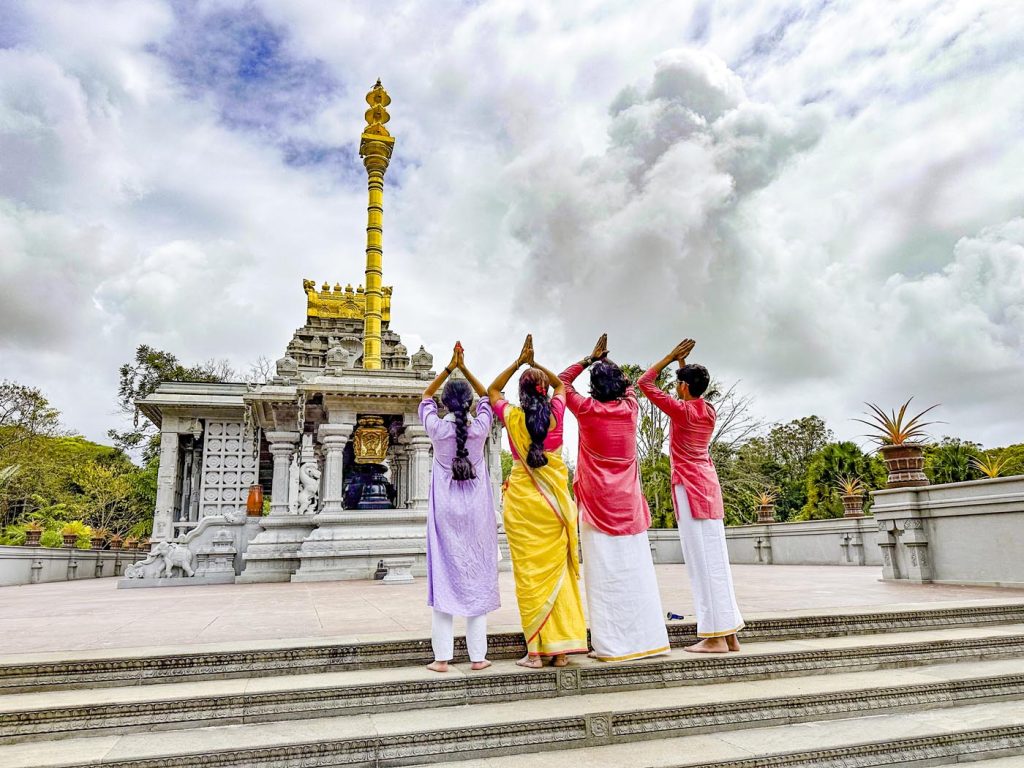
As soon as you arrive, stand humbly before the temple entrance. Raise your hands above your head in the prayerful gesture three, five, seven or nine times. You may prostrate here as well.
2. Remove Shoes, Rinse Feet & Hands
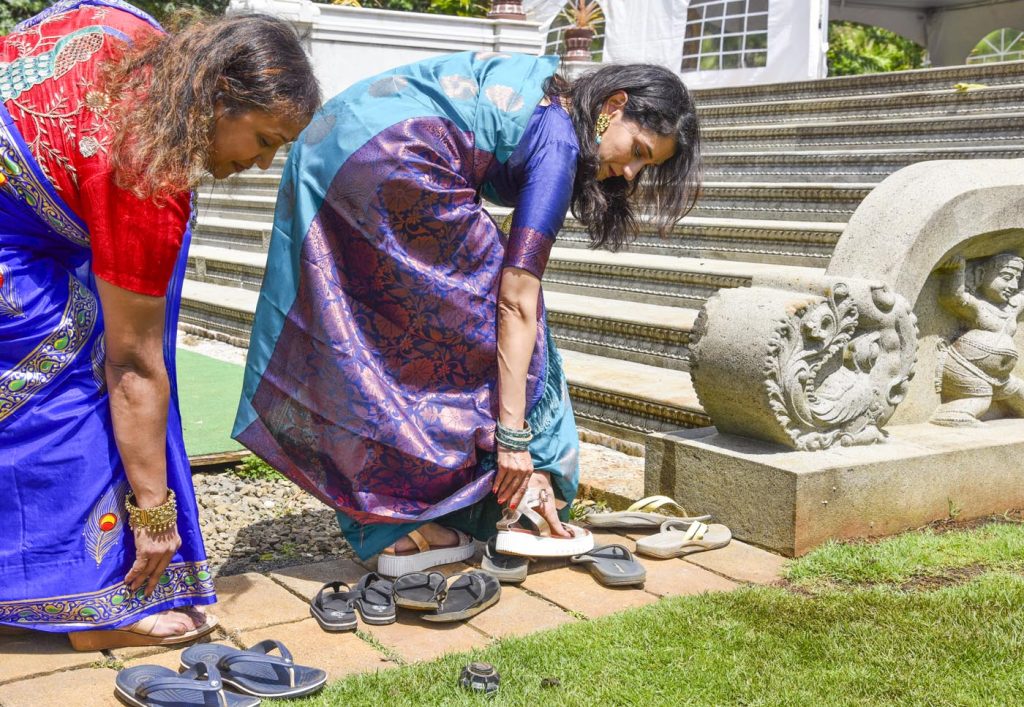
Remove your shoes (socks are usually OK to keep on, especially in cold climates). If a place is provided, rinse your mouth, feet and hands to purify yourself before entering the sacred premises.
3. Worship at the Flagpole
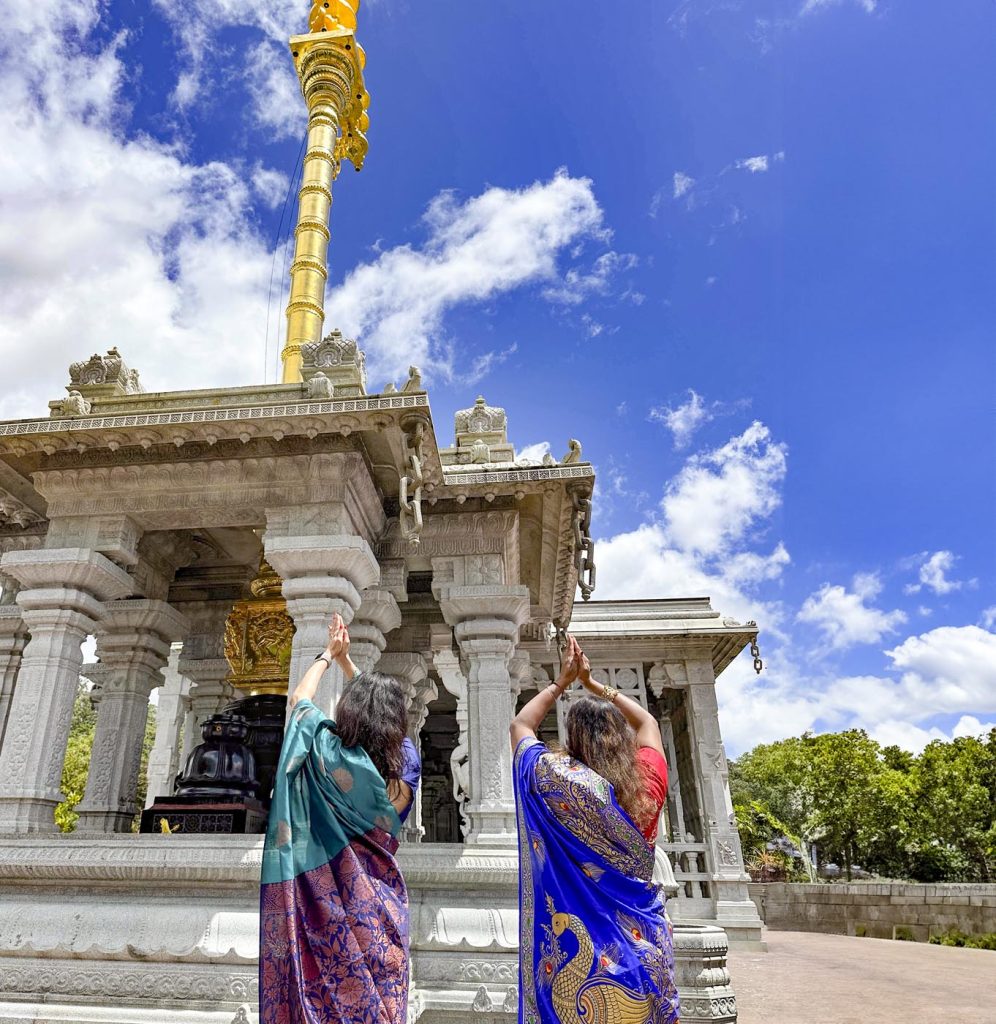
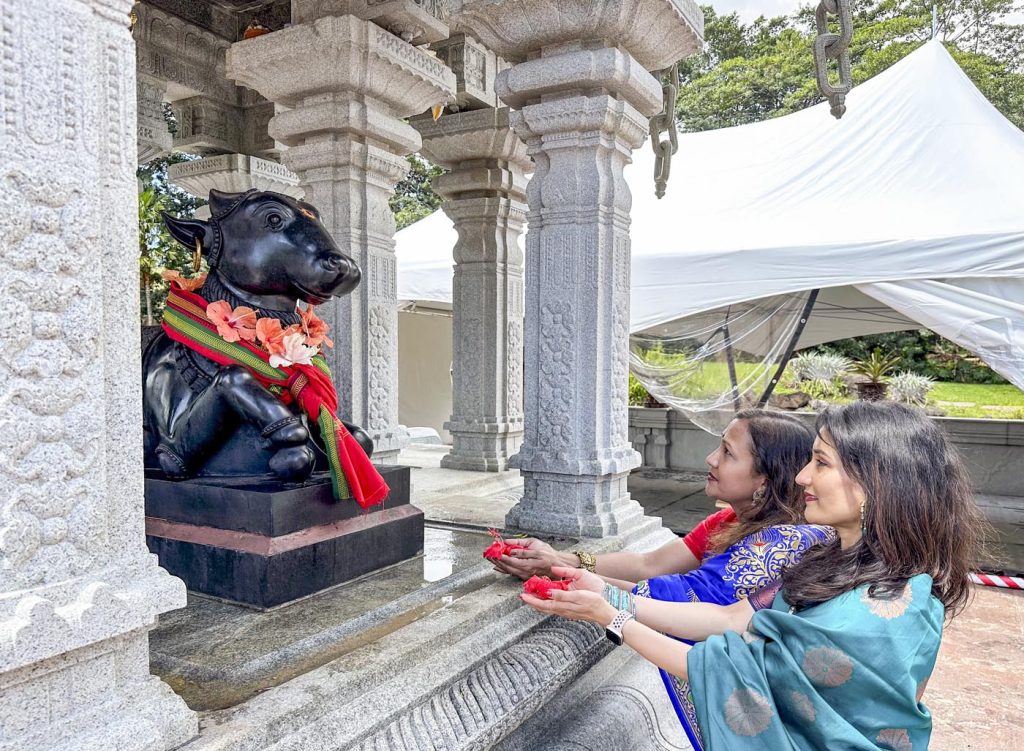
Many temples have a flagpole where one may prostrate and pray, and a balipitha, offering place, where negative thoughts are left. Then worship the Deity’s mount, or vahana. In Iraivan Temple it is Nandi the bull.
Worshiping & Attending Puja
4. Pray First to Lord Ganesha
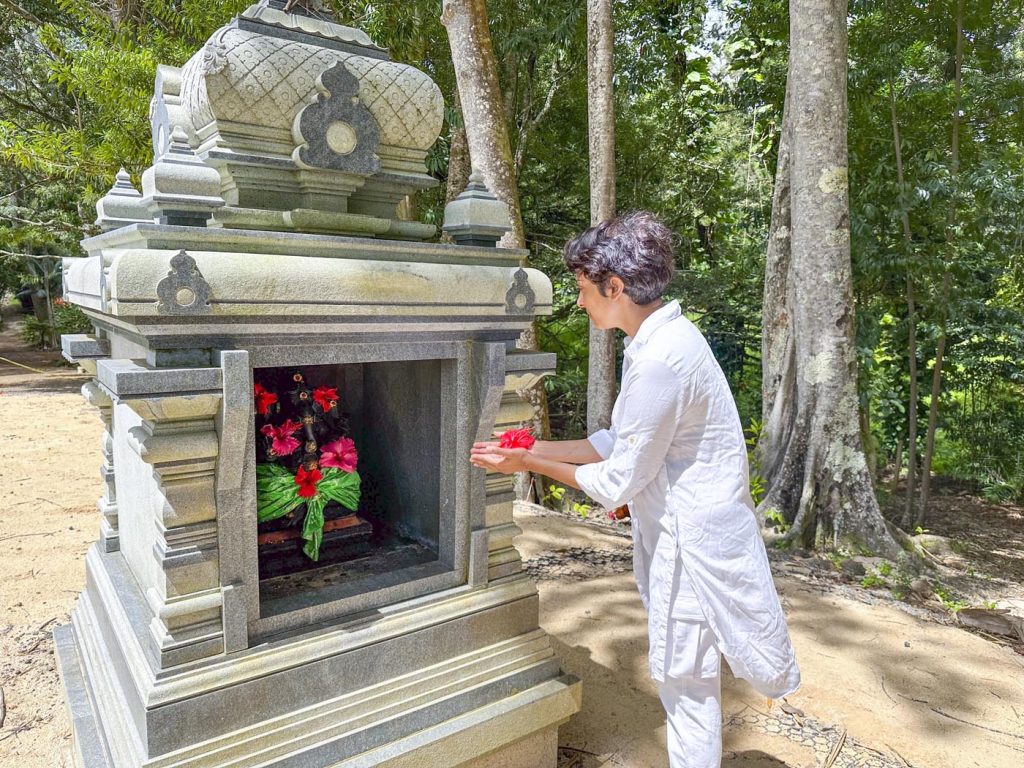
Worship Lord Ganesha, the Lord of Obstacles. By honoring Him first, the dynamic blessings of the temple will be opened to you.
5. Ring the Shrine Bell

Often there will be a small bell that you can ring to announce your arrival to the devas and Gods; its pure tones can easily be heard in the inner worlds.
6. Greet the Deities
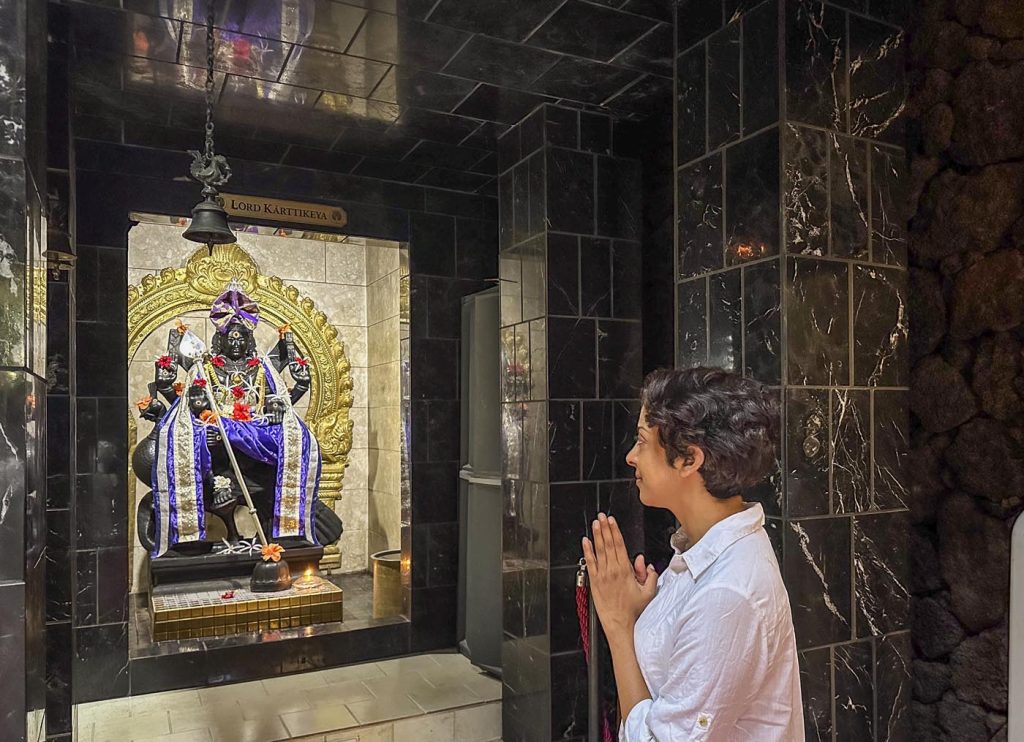
Visit and greet the Deity in each shrine. The priest will often guide the order to be followed and explain the unique powers of each Divinity. Offer a flower to each.
7. Walk Around the Sanctum

Walk clockwise one, three, five, seven or nine times around the main shrine, withdrawing your awareness from worldly matters and directing it toward the Divine.
8. Present Your Offering

Place before the shrine the offering tray or basket that you prepared at home or purchased (they may be available in stalls near the entrance). Put love into your offerings.
9. Sit for Puja

During the puja, don’t let your mind wander. This is the innermost time for reflection and communion. Devotees sit on the floor, then stand during the last part of a puja, and prostrate at the end.
Receiving the Puja Sacraments
10. The Arati Flame
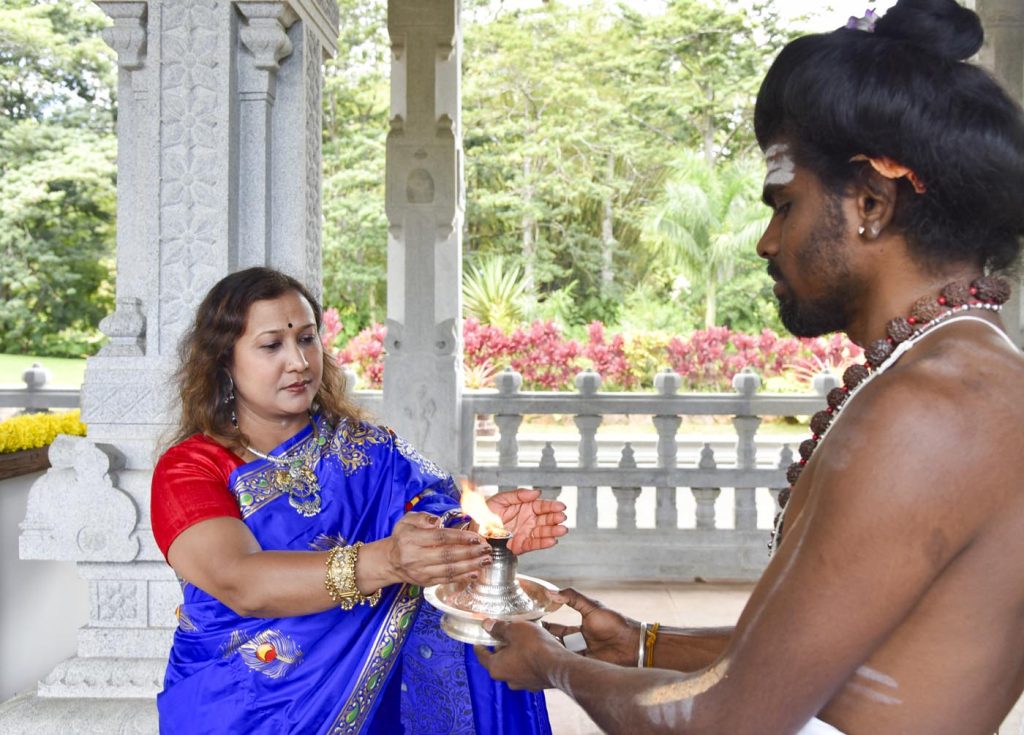
When the priest holds the lamp in front of you after puja, pass your open hands through the flame three times, lightly touching your eyes each time to draw the blessings into you.
11. Holy Ash
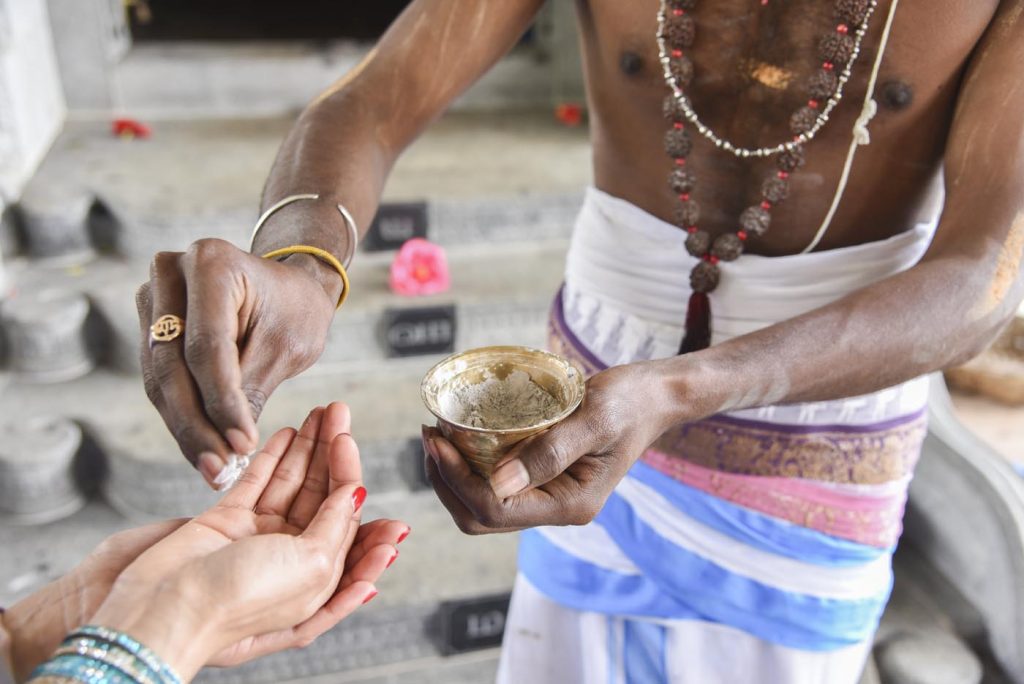
Accept the holy ash in your right hand. Transfer it to your left hand, then use the right hand to apply it to your forehead. Ash symbolizes transience of life and the burning away of impurity.
12. Blessed Water
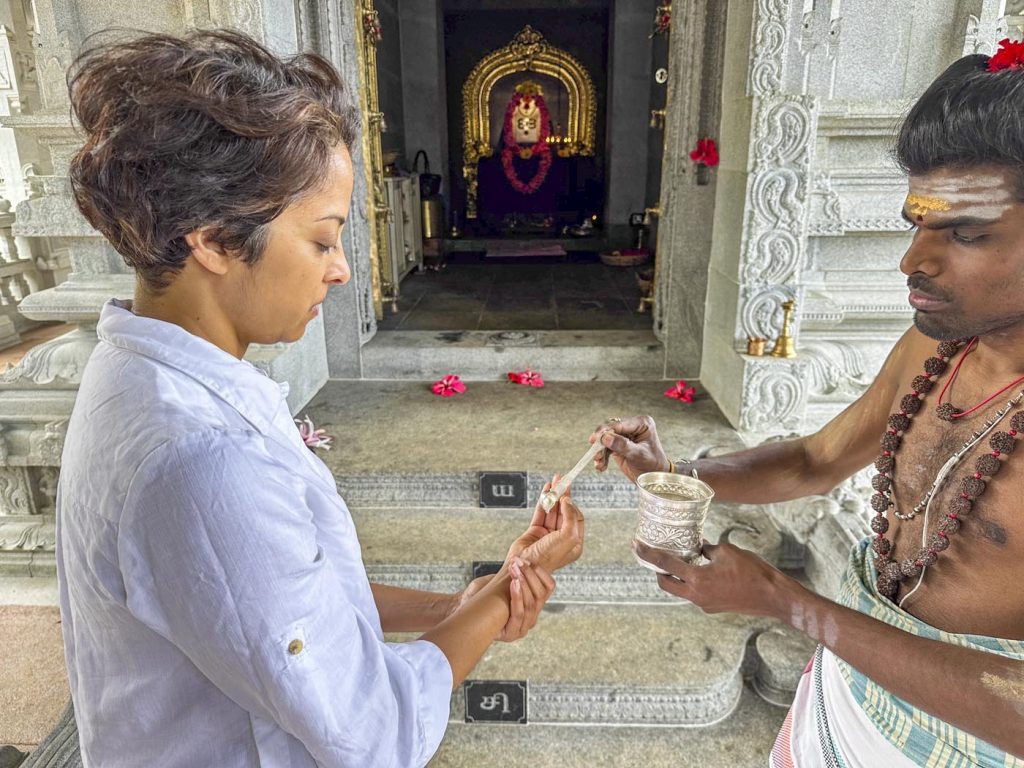
The priest will place a small spoonful of blessed water or milk into your cupped right hand. Bring your hand up to your mouth and sip it.
13. Sandalwood Paste & Kumkum
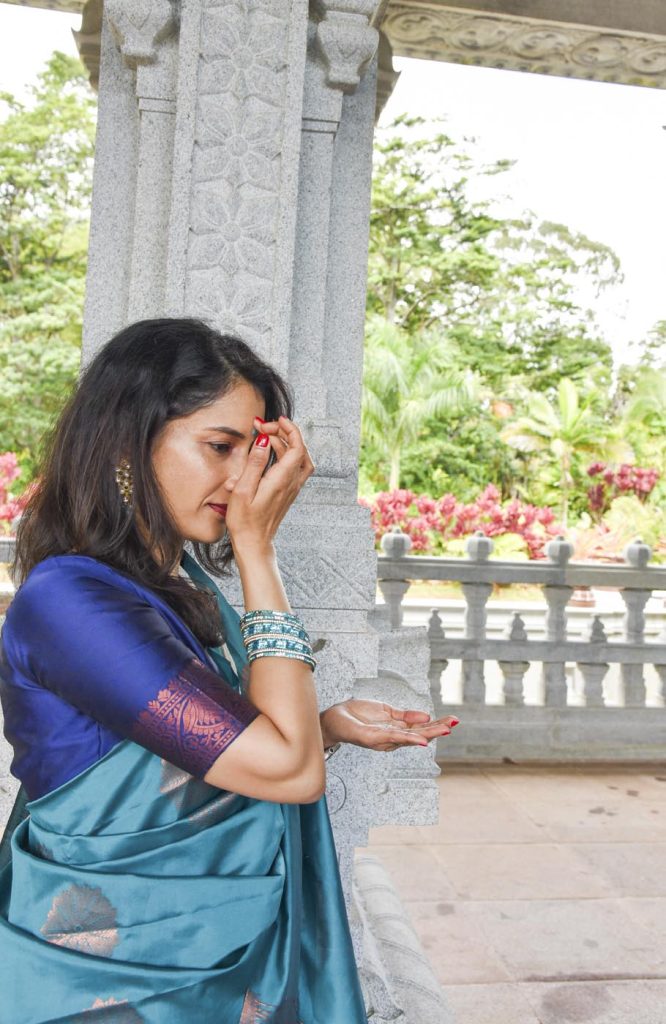
Fragrant sandalwood paste is then given, followed by red powder. Apply a dot of these in the middle of your brow with your right ring finger. See “about the sacraments” sidebar.
14. Prasada and a Flower
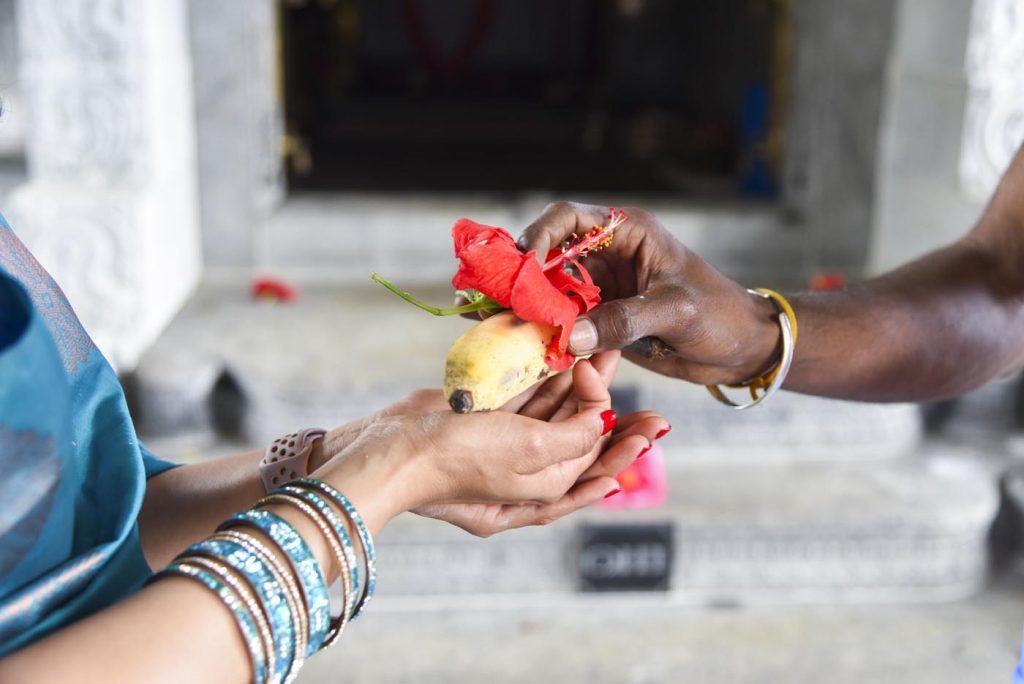
Blessed food (prasada) may then be given, such as a piece of fruit, a sweet or a spoonful of cooked food. Lastly, one may receive a flower that was offered to the Deity.
15. Monetary Offerings

It is customary to leave a monetary offering in the temple donation box. In addition, a donation may be placed on the arati tray to support the priests and their families.
After the Ceremony
16. Singing Bhajan
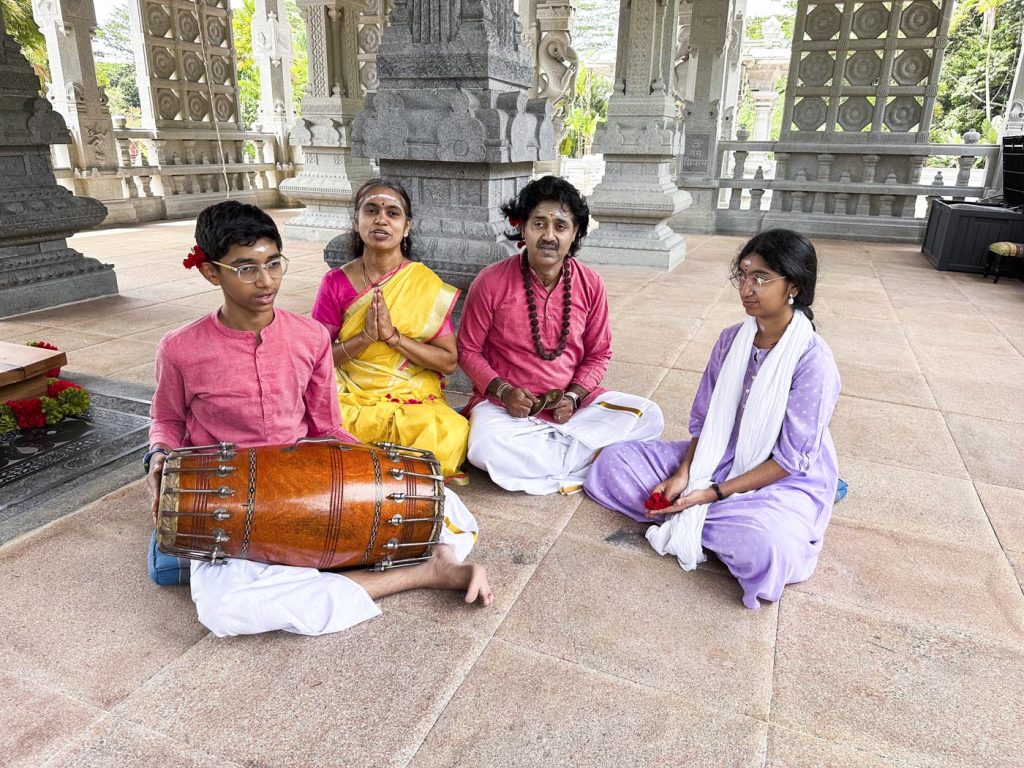
Singing is a superb way to express love and devotion. Bhajans and other hymns can be sung during the puja when the curtain is closed, or later on, by yourself or with a group.
17. Japa and Meditation

After the puja, sit quietly and meditate on the Divinity within yourself. This is an ideal time for japa, mentally repeating your mantra while counting on a strand of beads.
18. Archana for Personal Blessings

Archana is a personalized puja in which the priest recites to the Deity your name, lineage and birth star. To receive an archana, you pay a small fee and present an offering basket.
Did You Know?
All giving and receiving in the Hindu tradition is done only with the right hand or with both hands.
Six Secrets About Temple Worship
From Merging with Siva, by Satguru Sivaya Subramuniyaswami
1. One God, Many Gods
In the Hindu pantheon there are said to be 330 million Gods. Even so, all Hindus believe in one Supreme Being who pervades the entire universe. The many Gods are perceived as divine creations of that one Being. These Gods, or Mahadevas, are real beings, capable of thought and feeling beyond the limited thought and feeling of embodied man. So, Hinduism has one God, but it has many Gods. There are only a few of these Gods for whom temples are built and pujas conducted. Ganesha, Siva, Subramaniam, Vishnu and Shakti are the most prominent Deities in contemporary Hinduism. Of course, there are many others for whom certain rites or mantras are done in daily ceremony, often in the home shrine. These include Brahma, Surya, Sarasvati, Lakshmi, Agni, Chandra, Ayyappan, Hanuman, Mariyamman and others.
The Hindu traditionally adopts an Ishta Devata. This is a personal Deity chosen from the many Hindu Gods, often according to the devotee’s family background or the feeling of closeness to one form of divine manifestation. It is the unique and all-encompassing nature of Hinduism that one devotee may be worshiping Ganesha while his friend worships Subramaniam or Vishnu, and yet both honor the other’s choice and feel no sense of conflict. The profound understanding and universal acceptance that are unique in Hinduism are reflected in this faculty for accommodating different approaches to the Divine, allowing for different names and forms of God to be worshiped side by side within the temple walls. It may even happen that one may adopt a different personal Deity through the years according to one’s spiritual unfoldment and inner needs.
2. Temples Are Transformative!
Visiting a Hindu temple, receiving darshan from the majestic Gods of our religion, can altogether change the life of a worshiper. It alters the flow of the pranas, or life currents, within his body. It draws his awareness into the deeper chakras. It adjusts his beliefs and the attitudes that are the natural consequence of those beliefs. But the change is slow. He lives with the experience for months and months after his visit to the temple. He comes to know and love the Deity. The Deity comes to know and love him, helping and guiding his entire evolutionary pattern.
Darshan coming from the great temples of our Gods can change the patterns of karma dating back many past lives, clearing and clarifying conditions that were created hundreds of years ago and are but seeds now, waiting to manifest in the future. Through the grace of the Gods, those seeds can be removed if the manifestation in the future would not enhance the evolution of the soul.
3. Three Worlds Communing
Hinduism views existence as composed of three worlds. The First World is the physical universe, the Second World is the subtle astral or mental plane of existence in which the devas, or angels, and spirits live, and the Third World is the spiritual sphere of the Mahadevas, the Deities, the Gods. Hinduism is the harmonious working together of these three worlds. Religion blossoms for the Hindu as he awakens to the existence of the Second and Third Worlds. These inner worlds naturally inspire in man responses of love and devotion and even awe. They are that wonderful.
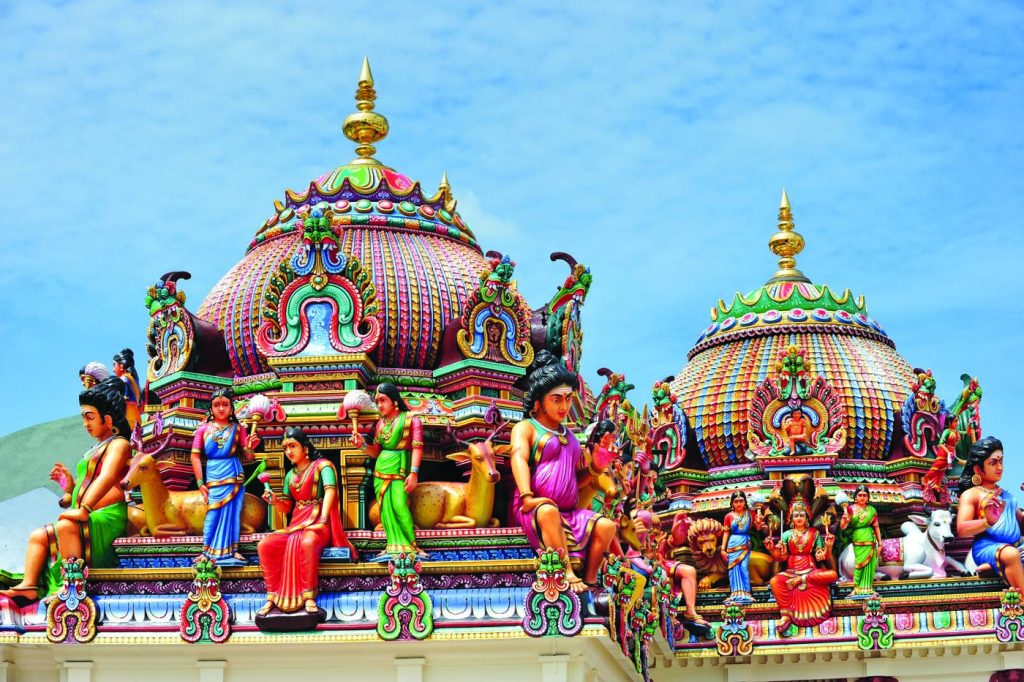
It is in the Hindu temple that the three worlds meet and devotees invoke the Gods of our religion. The temple is built as a palace in which the Gods reside. It is the visible home of the Gods, a sacred place unlike every other place on the Earth. The Hindu must associate himself with these Gods in a very sensitive way when he approaches the temple. These intelligent beings have evolved through eons of time and are able to help mankind without themselves having to live in a physical body. These great Mahadevas, with their multitudes of angelic devas, live and work constantly and tirelessly for the people of our religion, protecting and guiding them, opening new doors and closing unused ones.
The reality of the Mahadevas and their darshan can be experienced by the devotee through his awakened ajna vision, or more often as the physical sight of the image in the sanctum coupled with the inner knowing that He is there within the microcosm. This darshan can be felt by all devotees, becoming stronger and more defined as devotion is perfected. Through this darshan, messages can be channeled along the vibratory emanations that radiate out from the Mahadevas, as well as from their representatives, the Second World devas who carry out their work for them in shrines and altars.
4. Where Problems Can Be Dissolved
Hindus always want to live near a temple so they can frequent it regularly. When we go to the temple, we leave with our mind filled with the shakti of the Deity. We are filled and thrilled with the shakti of the temple in every nerve current of our body. When we return to our home, we light an oil lamp, and that brings the power of the temple into the home. This simple act brings the devas in the Second World right into your home, where they can bless the rest of the family who perhaps did not go to the temple.
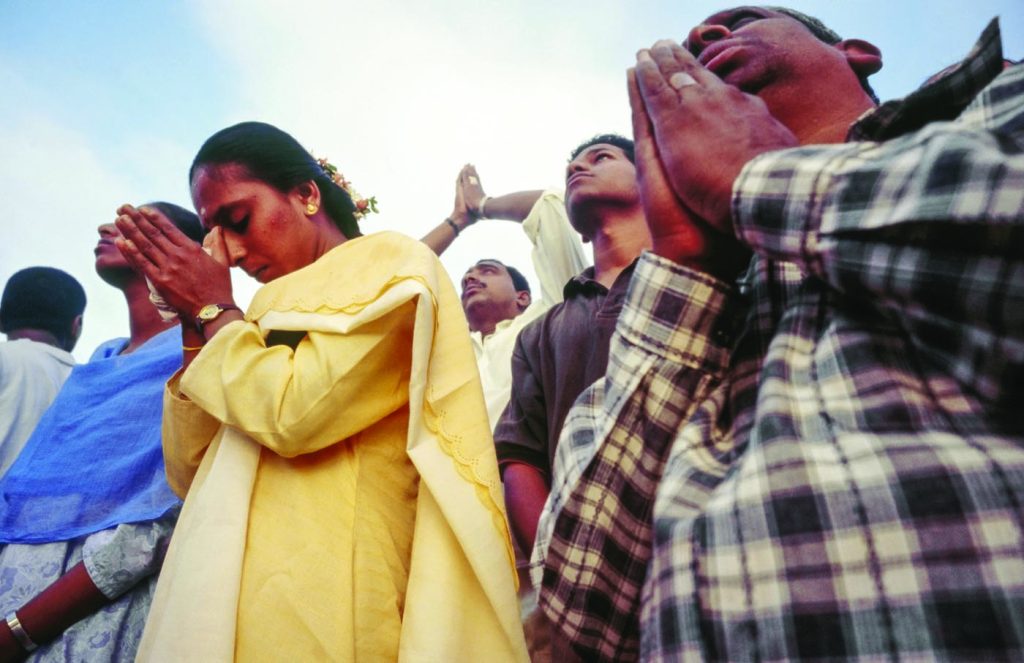
The devotee stands before the sanctum and telepathically tells the Gods a problem, and with hopeful faith leaves and waits. Days or weeks later, after he had forgotten about his prayer, he suddenly realizes the problem has disappeared. He attempts to trace the source of its solution and finds that a simple, favorable play of circumstance and events brought it about. Had the Gods answered his prayer, or would it have happened anyway?
He brings another prayer to the Gods, and again in time an answer appears in the natural course of his life. It appears to him that the Gods are hearing and responding to his needs. Trust and love have taken root. He goes on, year after year, bringing the Gods into his secular affairs, while just as carefully the Gods are bringing him into their celestial spheres, enlivening his soul with energy, joy and intelligence.
The Hindu looks to the Gods for very practical assistance. He devoutly believes that the Gods from their dwelling in the Third World are capable of consciously working with the forces of evolution in the universe and they could then certainly manage a few simpler problems. He devoutly believes that the Gods are given to care for man on the planet and see him through his tenure on Earth, and that their decisions are vast in their implications.
5. Puja Is Communion
The physical representation of the God, be it a stone or metal image, a yantra or other sacred form, simply marks the place that the God will manifest in or hover above in His etheric body. It can be conceived as an antenna to receive the divine rays of the God or as the material body in or through which the God manifests in this First World. Man takes one body and then another in his progression through the cycles of birth and death and rebirth. Similarly, the Gods in their subtle bodies inhabit, for brief or protracted spans of time, these temple images.
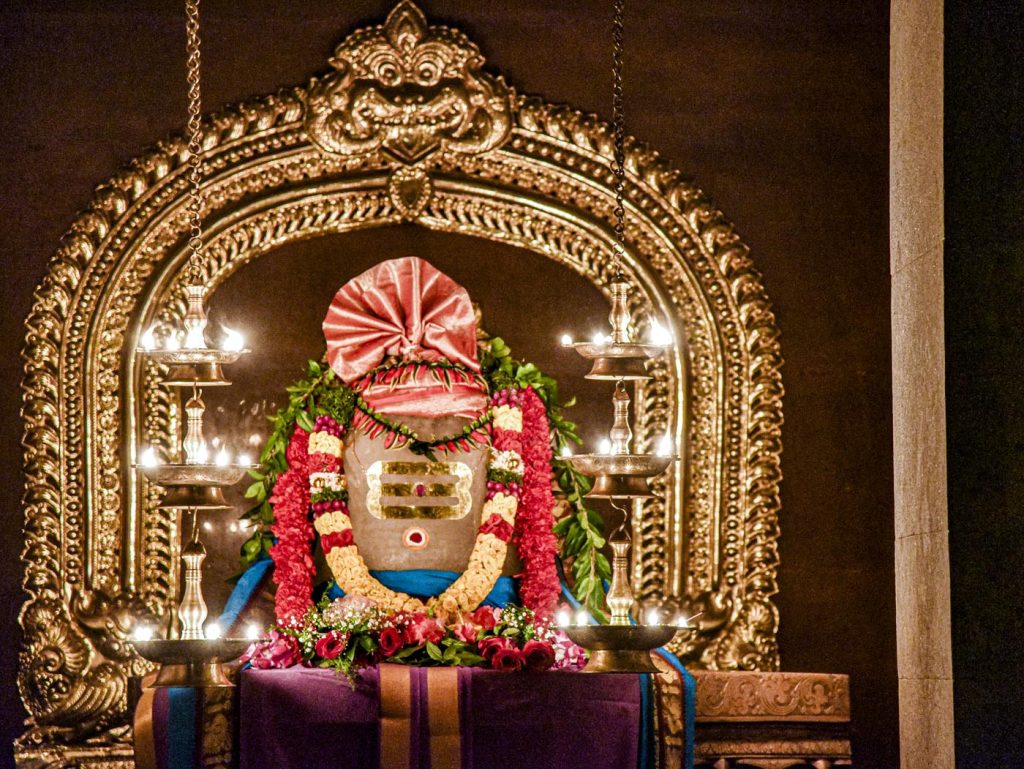
When we perform puja, a religious ritual, we are attracting the attention of the devas and Mahadevas in the inner worlds. That is the purpose of a puja; it is a form of communication. To enhance this communication, we establish an altar in the temple and in the home. This becomes charged or magnetized through our devotional thoughts and feelings, which radiate out and affect the surrounding environment.
Chanting and satsanga and ceremonial rituals all contribute to this sanctifying process, creating an atmosphere to which the Gods are drawn and in which they can manifest. By the word manifest, I mean they actually come and dwell there and can stay for periods of time, providing the vibration is kept pure and undisturbed. The altar takes on a certain power. In our religion there are altars in temples all over the world inhabited by the devas and the great Gods. When you enter these holy places, you can sense their sanctity. You can feel the presence of these divine beings, and this radiation from them is known as darshan.
6. Dealing with Disbelief
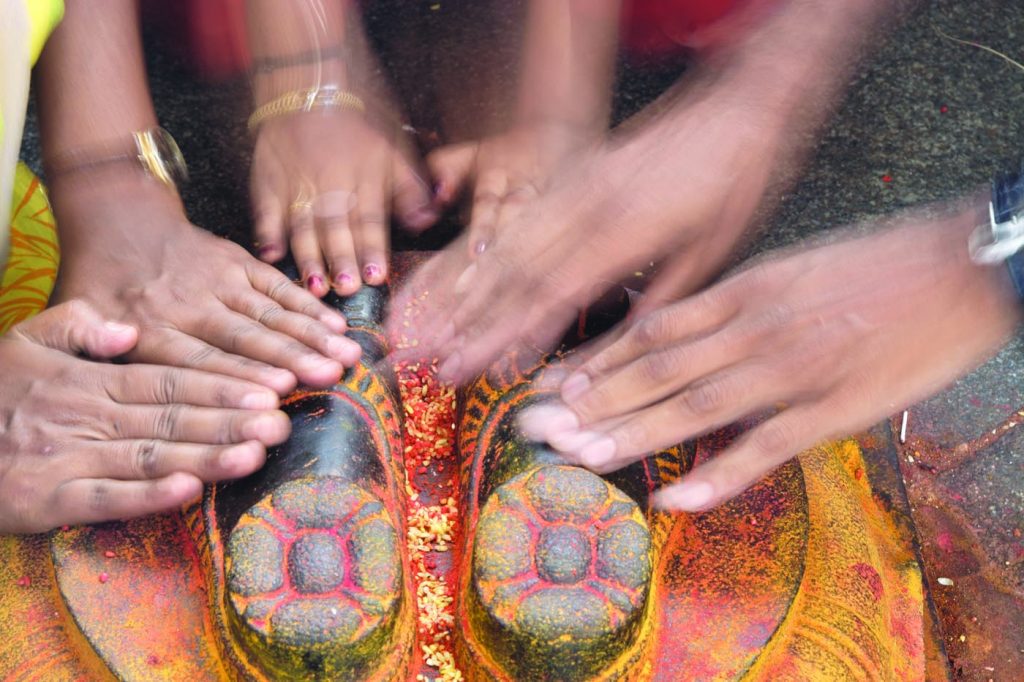
In the beginning stages of worship, a Hindu soul may have to wrestle with disbelief in the Gods. He may wonder whether they really exist, especially if his own intuition is obscured by assimilation of Western, existentialist beliefs and attitudes. Yet, he senses their existence, and this sensing brings him back to the temple. He is looking for proof, immersed in the process of coming to know the Gods for himself. He is heartened and assured by hundreds of saints and rishis who have fathomed and found close and enduring relationships with the Gods, and who then extolled their greatness in pages of scripture and chronicle.
The Gods of Hinduism create, preserve and protect mankind. Their overview spans time itself, and yet their detailed focus upon the complicated fabric of human affairs is just as awesome. It is through their sanction that all things continue, and through their will that they cease. It is through their grace that all good things happen, and all things that happen are for the good. Now, you may wonder why one would put himself under this divine authority so willingly, thus losing his semblance of freedom. But does one not willingly put himself in total harmony with those whom he loves? Of course he does. And loving these great souls comes so naturally. Their timeless wisdom, their vast intelligence, their thoroughly benign natures, their ceaseless concern for the problems and well-being of devotees, and their power and sheer godly brilliance—all these inspire our love.
This mural depicts typical activities in the precincts of a large temple, such as one would find in South India.
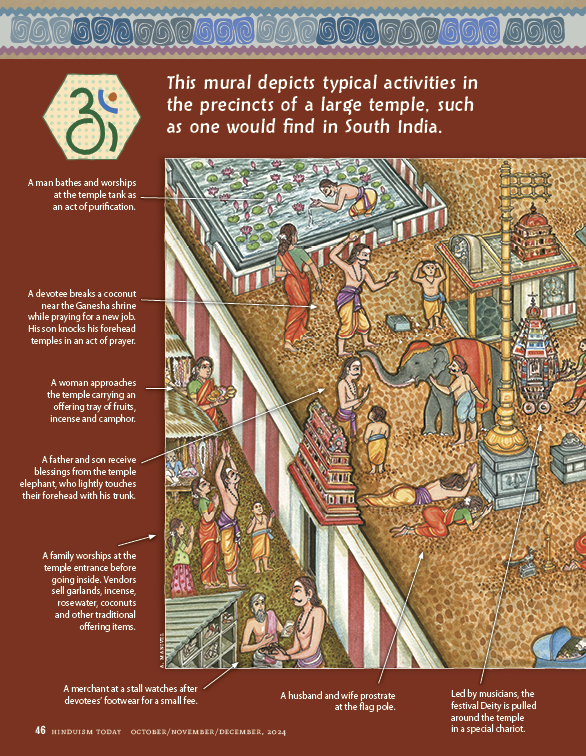
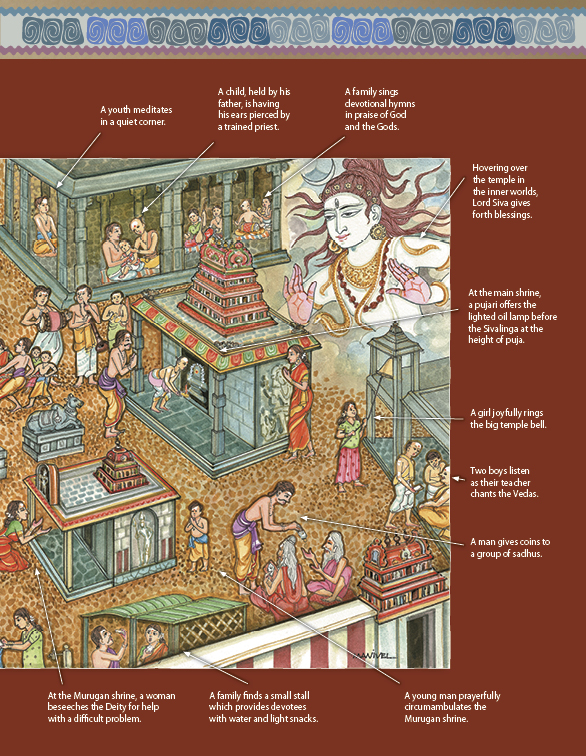
Questions & Answers
What is the cosmology that gives rise to the belief in Gods and devas?
Satguru Sivaya Subramuniyaswami: Hinduism views existence as composed of three worlds. The First World is the physical universe, the Second World is the subtle astral or mental plane of existence in which the devas, or angels, and spirits live, and the Third World is the spiritual sphere of the Mahadevas, the Deities, the Gods. Hinduism is the harmonious working together of these three worlds. Religion blossoms for the Hindu as he awakens to the existence of the Second and Third Worlds. These inner worlds naturally inspire in man responses of love and devotion and even awe. They are that wonderful.
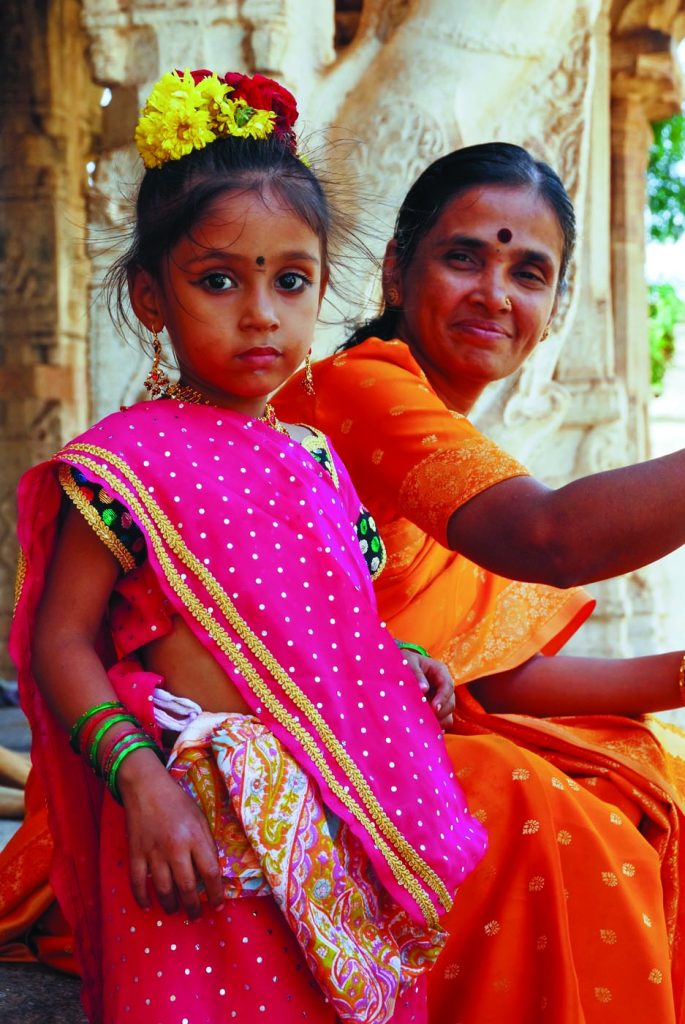
What is the significance of the temple?
BAPS Swaminarayan Sanstha: Mandir is the Hindu name for a place of worship or prayer. Mandir is a Sanskrit word meaning the place where the mind becomes still and the soul floats freely to seek the source of life, peace, joy and comfort. For centuries, the mandir has remained a center of life, a common community place where people forget their differences and voluntarily unite to serve society.
Sivaya Subramuniyaswami: On this Earth plane, the Gods have a special home, and that is the holy temple. It is in the sanctified temple, where regular and proper puja is being performed in a pure way, that the Gods most easily manifest. You can go to a Hindu temple with your mind filled up with worries, you can be in a state of jealousy and anger, and leave the temple wondering what you were disturbed about, completely free from the mental burdens and feeling secure. So great are the divine psychiatrists, the Gods of our religion, who live in the Third World, who come from the Third World to this world where our priests perform the pujas and invoke their presence over the stone image.
Why are temples needed?
BAPS: Every religion in its own tradition builds houses of worship. It is the mandir that fuels our faith in God, strengthens our society and teaches us to trust one another and to become trustworthy. Schools will educate the mind, but who will educate the soul? Hospitals will mend a broken arm, but who will mend a broken heart? Cinemas and arcades will excite the mind, but where will one go for peace of mind? The mandir is a center for learning about man, nature and God. It is where ethics and values are reinforced. It is where people celebrate festivals and seek shelter in sad times. It is where talents in various arts—music, literature and sculpture—are offered in the service of God.
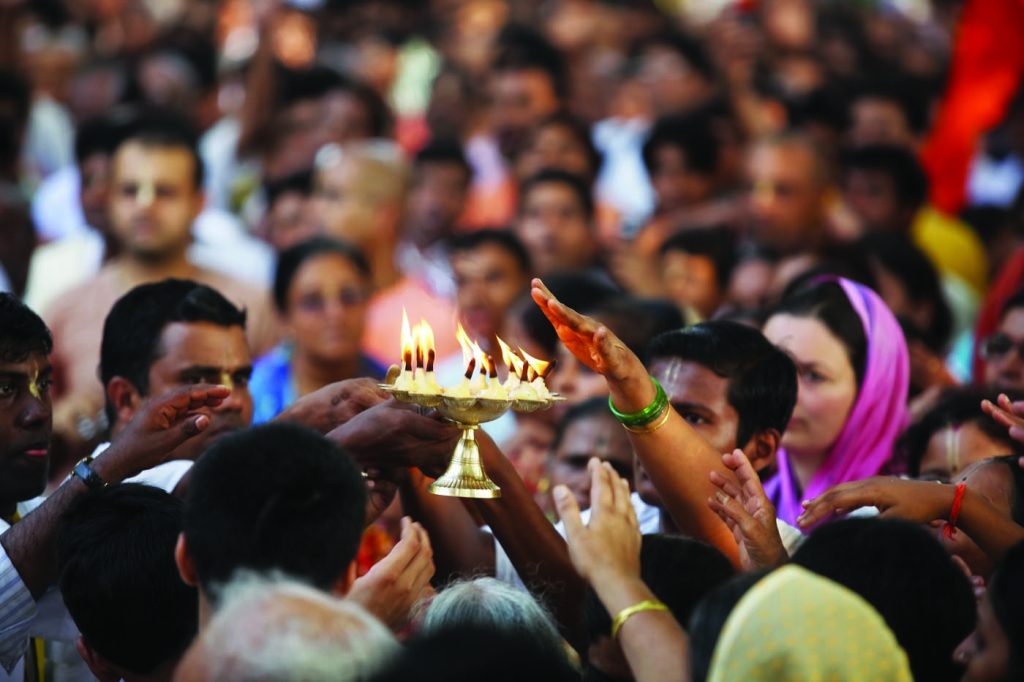
Are there varied views regarding the Gods and temple images, or murtis?
Yes, from the Agamic perspective, the murti is considered a sacred medium of the Divine. Another view is that the various murtis are symbols of the facets of Divinity.
Acharya Ananda Swami, Pitampura Temple, West Delhi: The sanctum sanctorum is the place where God resides. In Hindu culture, the idol is made based on the form of God which our rishis and saints saw through their penance and meditation. So, for us the idol is not just something made of stone; it is a form of God, a living God. These idols are established in the temples following directions given in our Shastras and Vedas. Once the idol is established with due rituals, that place becomes the garbhagriha, or sanctum sanctorum. To maintain the purity of the temple, only the priest can enter the sanctum or touch the Deity.
Chinmaya Mission: God, the infinite, the formless, is exceedingly hard to contemplate upon. Most of us need some grosser expression. Symbols of the eternal principle are called idols, murtis. These idols represent the eternal principle, God, the ideal.… If we are not yet able to see the Lord in everything, we are asked to first practice seeing him in at least one image and then slowly expand our vision (Bal Vihar Teacher’s Handbook, Grade Five).
BAPS: Sanatan Dharma believes in murti puja—worshiping Bhagwan, His avatars and Deities in the form of images. Followers believe in the presence of the Divine in such images and offer them worship with faith (shraddha) and loving devotion (bhakti). In turn, due to His grace, the Divine accepts this bhakti. Throughout Sanatan Dharma’s history, He has let His manifestations and Divinity be known through various murtis and [miraculous] events.
How should one prepare to go to the temple?
Acharya Ananda Swami: Devotees should come with complete mental and physical purity. In the temple the devotees should engage in bhajan, kirtan and worship of God. Before we enter the temple, we must purify ourselves by sprinkling of water and also purify our inner self by chanting holy mantras. Even our dress should be sattvic and light colored or even white. We must wear fresh clothes and avoid wearing leather items, like belts and shoes. Our heart should have sattvic feelings when we come to the temple.
Why have many temples in the Hindu diaspora combined the functions of temple and satsang hall in one facility?
Pandit Roopnauth Sharma, Ram Mandir, Toronto: When people move from an environment they are accustomed to, they try to accommodate situations and in so doing may create a new approach to getting something done. When people settled in the colonial countries, they were given accommodations in simple lodges, and there was only one gathering hall. They placed the Deity there, did their puja there and congregated there for satsang. They held their havan there as well. But in India that would not happen. In the Caribbean, it became a place for darshan and shiksha (teaching) and satsang, because it was the only place they had, and this is what is evolving in North America today—like our congregation here in Ram Mandir. We are trying to create an environment where people come and sit and listen and learn, an institution not only for darshan but for spiritual learning, and learning about the Hindu way of life.
Padmaja Patel, Midland, Texas: In North America, in addition to temples of traditional South Indian style, there are many community temples which include a satsang hall and murtis. Our local temple falls in that category. To best utilize the space and money, we also have a stage in the hall for children’s cultural performances. The current design serves our small community well. The other important factor is that some of the smaller communities cannot afford to have a full-time priest, so this type of non-traditional temple serves them well.
Acharya Ananda Swami: In North India there are also many temples where the design is such that the idols are placed inside a satsang hall.
What is the purpose of walking around the temple or shrine?
Acharya Ananda Swami: There is a special importance of pradakshina (or parikrama). For different Gods and Goddesses there are different numbers of pradakshina one has to undergo. Most knowledgeable devotees undertake pradakshina as part of their routine of worship. The devotee can do general pradakshina for all the Gods, once, thrice, eleven, twenty-one, fifty-one times or even more.
Sivaya Subramuniyaswami: When we come to the temple out of the world, off the street, we are often shrouded by negative vibrations, which can actually be seen in our aura. Our nerve system may be upset, especially now, in the technological age, when we often suffer from stress and strain, the insecurity of so many changes and the rapid pace of life. In order to prepare ourselves to enter the sanctum sanctorum of the temple, the great mandapam inside, we walk clockwise around the temple very slowly. In this way we prepare our mind. We consciously drop off worldliness, letting the sufferings go, letting all disturbances leave our mind the best we can, and trying to reach deep inside of ourselves where peace exists eternally. We become as celestial as we can during the time we are walking around the temple, so that we can communicate with the celestial beings within the temple.
How does the temple help individuals?
BAPS: A hectic routine packed with work tensions and idealistic ambitions, imperfect relationships and demanding family stresses, leaves the average individual with an ardent craving for answers to life’s unlimited questions; the most burning being: “How can I attain peace of mind?” Sometimes the individual may turn to alcohol, substance abuse, crime, gambling or other such vices, helplessly in search of peace. Many genuine efforts are also made, such as recreational activities, days off or retreats. The mandir offers a refreshing tranquility. Through its natural teachings and activities of prayer and worship, the mandir generates devout faith in God and in fellow man and guides the individual towards spirituality. With this new-found faith in God, the individual embraces physical, mental and spiritual purity. The teachings and natural activities of the mandir offer the individual an understanding that peace of mind does not lie in addictions and other such vices. They mold the character of the individual by endowing basic virtues of humanity, such as fidelity, courage, forgiveness, unity, friendship, honesty, humility, tolerance, understanding, patience, charity and universal brotherhood. Thus, the mandir also plays an indirect role in improving society by improving the state of the individual.
What is the significance of the showing of lights?
BAPS: Only through the light of knowledge can one welcome Bhagwan in one’s heart. The symbol of this knowledge is light. Only in the light can one have Bhagwan’s darshan. Arati is the ritual that welcomes Bhagwan with light.
Acharya Ananda Swami: Fire worship has a significant role in the temple. It is used in the puja and archana. We light the dipas and perform the arati in which the role of fire is very important. When special festivals or functions are held, dipas or lamps are lit ’round the clock.
What cultural importance does the mandir have?
BAPS: Throughout the history of Hindu civilization, mandirs have been the most significant patrons of architecture, sculpture and painting. Mandirs were also great patrons of the performing arts, supporting the performance and teaching of devotional vocal and instrumental music. Mandirs also promoted a tradition of devotional dance. These traditions of music and dance were developed in the mandir and spread out into the wider culture. Without the mandir’s patronage, these priceless artistic traditions would not be available for the world to appreciate today.
Is Temple Worship Only for Beginners?

Temple worship is for all men and women at every level of spiritual development. Its meaning and experience deepen as we unfold spiritually through the stages of service, devotion, yoga and enlightened wisdom.
Other Temple Events
Have faith in God. Believe in Him with all your heart. Think that in the world He is for you the sweetest of all sweet things. Think that there is nothing other than God. Sitting or standing, walking or lying down, think of Him. Let the thought of Him permeate your nerves, flesh and blood.
Natchintanai 7, Satguru Yogaswami of Jaffna
Annual Festivals
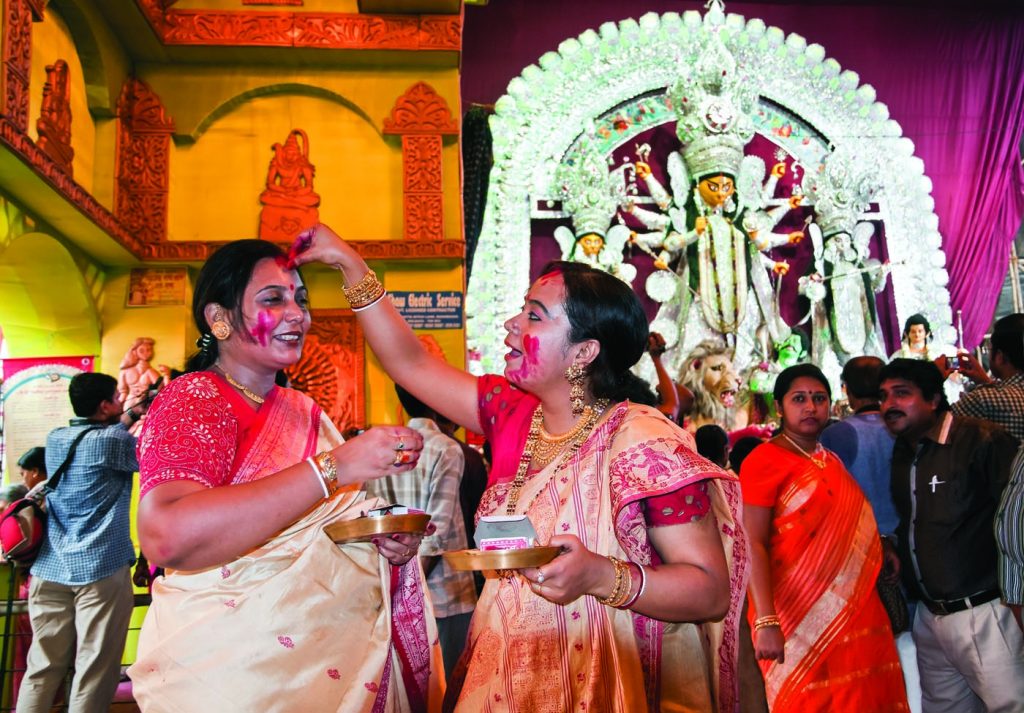
Many annual festivals are celebrated in temples. These are auspicious days when the veil between the worlds is thin and God and the Gods can touch our world. Festivals provide the opportunity to go on pilgrimage, journeying to a far-off temple for blessings and renewal. Celebrated with unmatched fervor but with paced regularity, festivals serve as a reminder of one’s identity and allegiance to Hindu traditions and ideals. As Professor Dr. Shiva Bajpai remarked, “Festivals, pilgrimages and temple worship are the faith armor of Hindus.”
Rites of Passage

A central part of every Hindu’s life, samskaras are sacred rites of passage, such as coming of age and marriage, and childhood rites, including name-giving, first feeding, ear-piercing and head-shaving. They are held in temples, homes or halls. You may observe samskaras in progress during your visit. Consult with the temple priest for more information. These rites usually include a puja and a homa, or fire ceremony. If you request a samskara, the priest will set an auspicious time, explain how to prepare, what to bring, and what to do during the ceremony.
Fire Rites
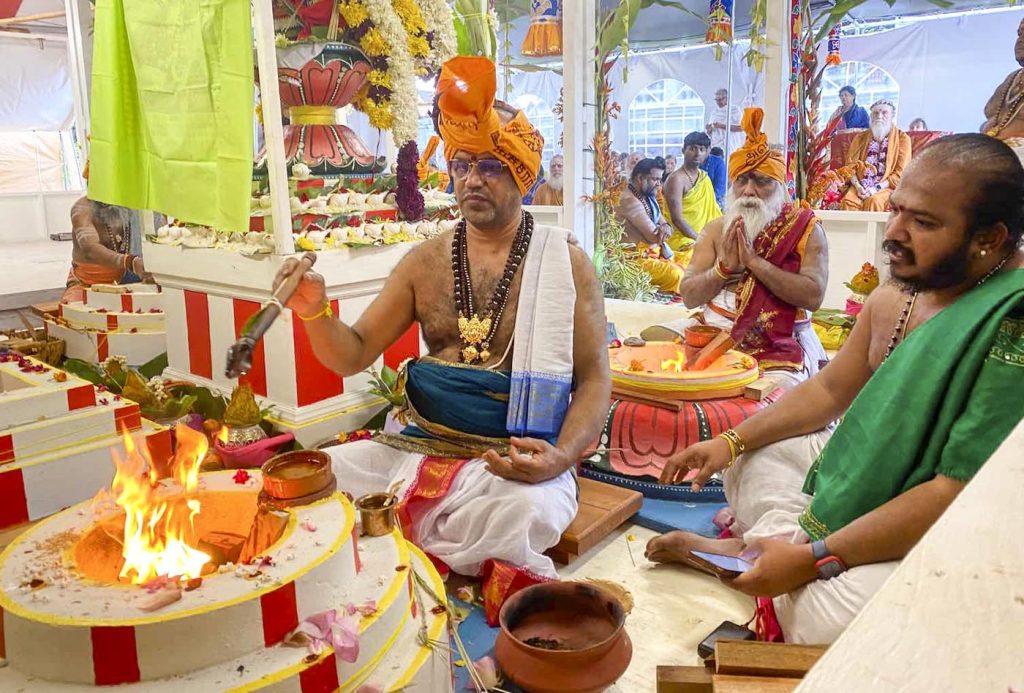
Major pujas in temples are often preceded by a homa, or “fire-offering,” among the most ancient forms of Hindu worship. Fire is the object of worship, and oblations are offered into a sanctified fire pit, which is usually made of earthen bricks. One or more priests sit near and tend the fire, offering wood, ghee, grains and dried herbs while chanting mantras from the Vedas and Agamas. The rites invoke the temple’s main Deity as well as other Gods, such as Ganesha, Agni and Varuna.
Did You Know?
In a Hindu temple there is often a multiplicity of simultaneous proceedings and ceremonies. In one corner, an extended family, or clan, with its hundreds of tightly knit members, may be joyously celebrating a wedding. At another shrine, a lady might be crying in front of the Deity, saddened by some misfortune and in need of solace. Elsewhere in the crowded precincts, a baby is being blessed, and several groups of temple musicians are filling the chamber with the shrill sounds of the nagasvaram and drum. After the puja reaches its zenith, brahmin priests move in and out of the sanctum, passing camphor and sacred ash and holy water to hundreds of worshipers crowding eagerly to get a glimpse of the Deity. All of this is happening at once, unplanned and yet totally organized. It is a wonderful experience, and such a diverse array of devotional ceremonies and such an intensity of worship can only be seen in a Hindu temple. There is no place on Earth quite like a Hindu temple.
Living with Siva
How Do Our Prayers Reach the Gods?
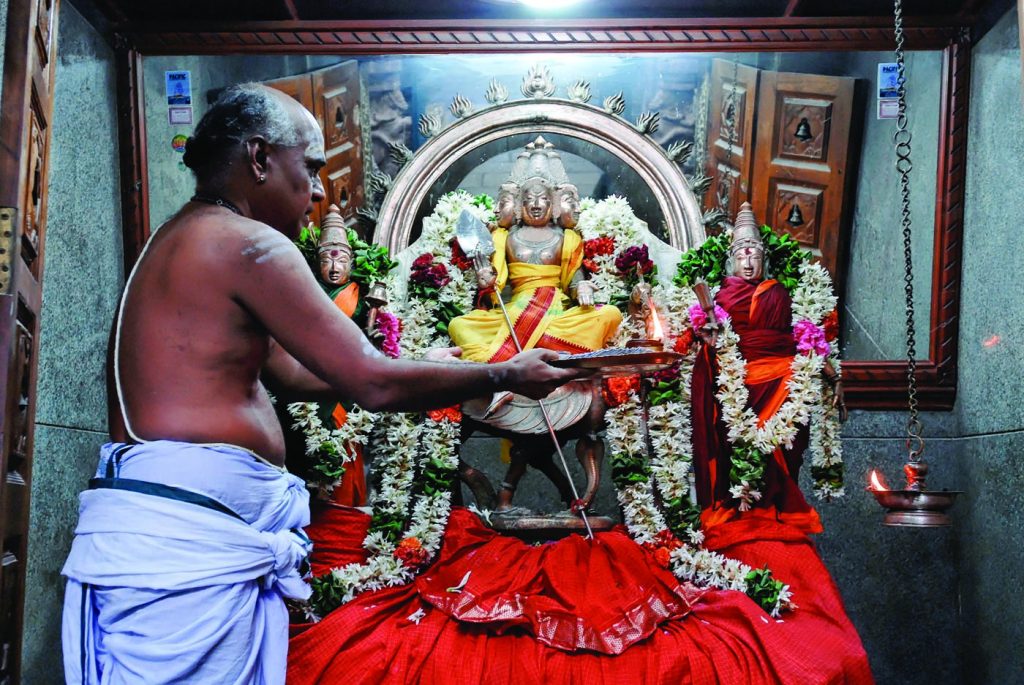
Through temple worship, the three worlds become open to one another, and the beings within them are able to communicate. By means of the mystical arts of puja, the worlds act in concert, and prayers are received. Aum.
Ten Tips to Make the Most of Your Visit
1. Attend a puja at the temple at least once a week. Experiencing the divine energy of God and the Gods on a regular basis helps keep you pure and strong in your religious commitments.
2. Dress in traditional Hindu clothing. This helps put you in a religious mood. Keep special clothing just for the temple.
3. Make your travel to the temple a religious time. This prepares you to arrive in a spiritual frame of mind. Don’t focus on problems or projects at home, work or school. Don’t think or talk about politics or business. Listen to religious music or chanting while in transit. Tell the children uplifting stories.
4. Bring an offering. Ideally, bring a flower, flower garland or fruit for each shrine at which you worship. The act of giving makes you receptive to blessings.
5. Put prana into what you offer. Prana is the energy that exudes from your hands. Buying a garland is good, but making one is even better. When the priest puts your hand-made garland on the murti, it’s almost like you are touching the Deity yourself.
6. Focus on the worship service and the priest’s chanting. Don’t let the mind wander. Learn, at least generally, the meaning of what the priest is chanting. Similarly, when singing bhajans, keep focused on the meaning of the song.
7. Stay for a while after the ceremony. Don’t rush away. Sit and meditate. Bask in the divine energy of the temple. This is also an ideal opportunity for japa.
8. Light an oil lamp in your shrine room when you get home. This brings devas who were at the temple right into your sacred space. From the inner world, they will bless the family and strengthen the spiritual force field of the home.
9. Watch for auspicious days. The Deity’s presence is stronger on some days than others. By attending the temple on the most auspicious days, you become attuned to the Deity’s blessings. For example, blessings are especially strong during the annual festival days.
10. Gain strength by taking vows. It is common to take a vow, or vrata, during festivals. A typical vrata is to fast during a day of temple ceremonies and break the fast that evening.
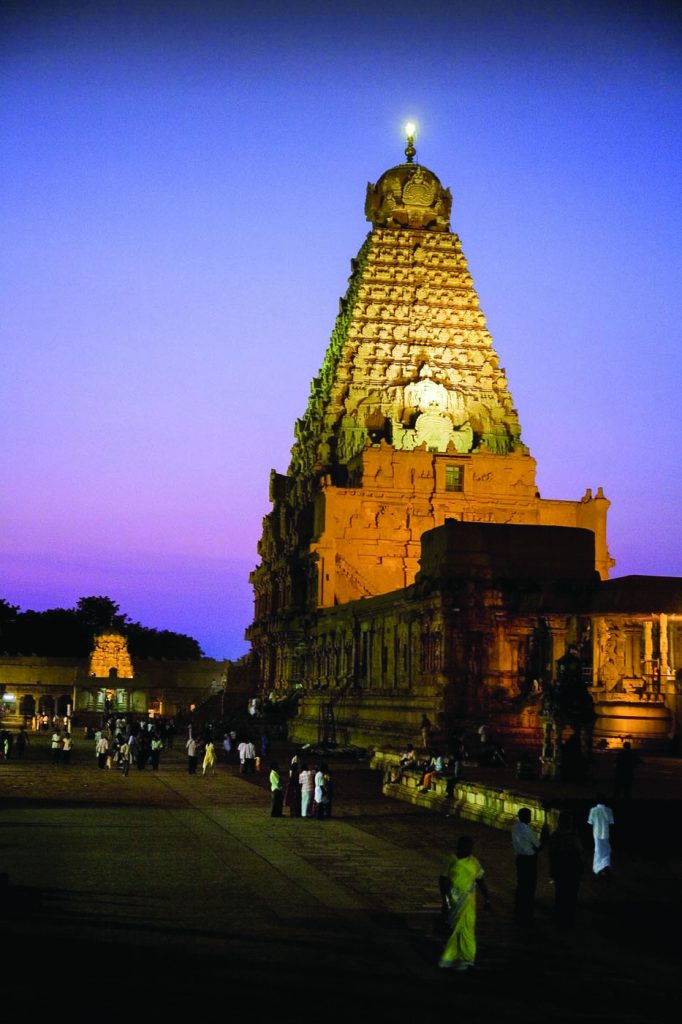
Thank you! I will ready this again and again as I prepare to visit.